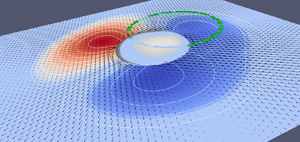Published online by Cambridge University Press: 18 November 2022

We consider a two-dimensional (2-D) model of an autophoretic particle. Beyond a certain emission/absorption rate (characterized by a dimensionless Péclet number,  $Pe$) the particle is known to undergo a bifurcation from a non-motile to a motile state, with different trajectories, going from a straight to a chaotic motion by increasing
$Pe$) the particle is known to undergo a bifurcation from a non-motile to a motile state, with different trajectories, going from a straight to a chaotic motion by increasing  $Pe$. From the full model, we derive a reduced closed model which involves only two time-dependent complex amplitudes
$Pe$. From the full model, we derive a reduced closed model which involves only two time-dependent complex amplitudes  $C_1(t)$ and
$C_1(t)$ and  $C_2(t)$ corresponding to the first two Fourier modes of the solute concentration field. It consists of two coupled nonlinear ordinary differential equations for
$C_2(t)$ corresponding to the first two Fourier modes of the solute concentration field. It consists of two coupled nonlinear ordinary differential equations for  $C_1$ and
$C_1$ and  $C_2$ and presents several advantages: (i) the straight and circular motions can be handled fully analytically; (ii) complex motions such as chaos can be analysed numerically very efficiently in comparison with the numerically expensive full model involving partial differential equations; (iii) the reduced model has a universal form dictated only by symmetries (meaning that the form of the equations does not depend on a given phoretic model); (iv) the model can be extended to higher Fourier modes. The derivation method is exemplified for a 2-D model, for simplicity, but can easily be extended to three dimensions, not only for the presently selected phoretic model, but also for any model in which chemical activity triggers locomotion. A typical example can be found, for example, in the field of cell motility involving acto-myosin kinetics. This strategy offers an interesting way to cope with swimmers on the basis of ordinary differential equations, allowing for analytical tractability and efficient numerical treatment.
$C_2$ and presents several advantages: (i) the straight and circular motions can be handled fully analytically; (ii) complex motions such as chaos can be analysed numerically very efficiently in comparison with the numerically expensive full model involving partial differential equations; (iii) the reduced model has a universal form dictated only by symmetries (meaning that the form of the equations does not depend on a given phoretic model); (iv) the model can be extended to higher Fourier modes. The derivation method is exemplified for a 2-D model, for simplicity, but can easily be extended to three dimensions, not only for the presently selected phoretic model, but also for any model in which chemical activity triggers locomotion. A typical example can be found, for example, in the field of cell motility involving acto-myosin kinetics. This strategy offers an interesting way to cope with swimmers on the basis of ordinary differential equations, allowing for analytical tractability and efficient numerical treatment.
Present address: Department of Biomedical Engineering, Indian Institute of Technology Hyderabad, Kandi, Sangareddy, 502285, Telangana, India.